All Images
Research News
A Crowded World
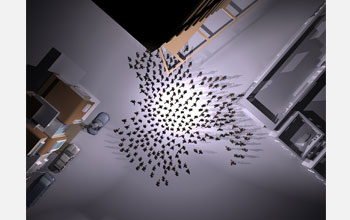
The fleeing crowd has enough room to egress efficiently through the urban canyon formed by the interstitial space between buildings.
Credit: Dr. Paul M. Torrens
Download the high-resolution JPG version of the image. (219 KB)
Use your mouse to right-click (Mac users may need to Ctrl-click) the link above and choose the option that will save the file or target to your computer.
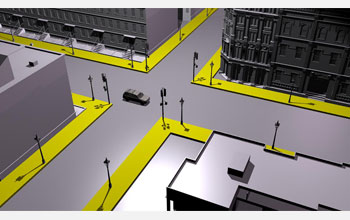
The researchers are designing realistic synthetic cities, which may be flooded with agents of diverse types and behaviors. These synthetic cities then serve as an artificial laboratory for exploring scenarios of human movement and social interaction in urban environments and for diverse scenarios.
Credit: Dr. Paul M. Torrens
Download the high-resolution JPG version of the image. (119 KB)
Use your mouse to right-click (Mac users may need to Ctrl-click) the link above and choose the option that will save the file or target to your computer.
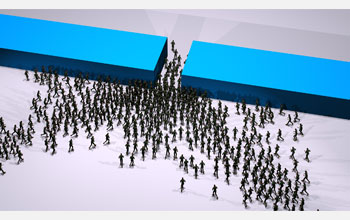
A large auditorium is cleared calmly through a small exit. From an initial start point of rest, agents begin to evacuate a large auditorium quickly by running as fast as possible to safety through a narrow exit. Wedge-like bottlenecks soon form at the mouth of the exit corridor and congestion begins to ripple back through the crowd, impeding further clearing. Similar dynamics are often observed during rush hour commutes on highways.
Credit: Dr. Paul M. Torrens
Download the high-resolution JPG version of the image. (367 KB)
Use your mouse to right-click (Mac users may need to Ctrl-click) the link above and choose the option that will save the file or target to your computer.
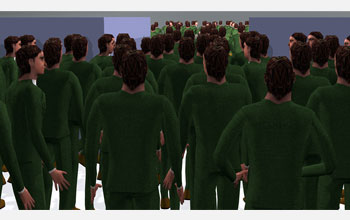
As congestion forms, the crowd forms into a large wedge-like mass around the exit, restricting evacuation to all but a trickle. A similar phenomenon is often observed on highways, when gridlock forms around highway entrance and exit ramps during rush hour. Individual agents lose track of their position relative to the exit and revert to follow-the-leader behavior, this explains the wedge-like formations.
Credit: Dr. Paul M. Torrens
Download the high-resolution JPG version of the image. (141 KB)
Use your mouse to right-click (Mac users may need to Ctrl-click) the link above and choose the option that will save the file or target to your computer.
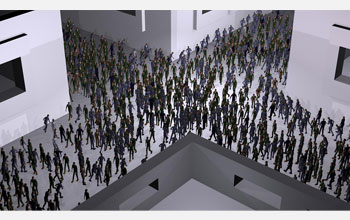
In this scenario, the model is run with 14 different agent types, ranging from children to adult to seniors, males, females, agents with ambulatory difficulties, intoxicated agents, "pushy" agents and "passive" agents. For each agent type, varying behaviors are programmed and the agents are endowed with diverse body language from motion capture data.
Credit: Dr. Paul M. Torrens
Download the high-resolution JPG version of the image. (179 KB)
Use your mouse to right-click (Mac users may need to Ctrl-click) the link above and choose the option that will save the file or target to your computer.
